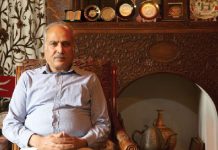[cycloneslider id=”khandwa-jailbreak”]
Nineteen years after it had wrested the area from the Marathas, the East India Company built a prison in Khandwa town of Madhya Pradesh. The Company and the British viceroyalty that succeeded it are long gone. But the stone-and-mortar edifice of 1837 stands much the same, decaying from nearly two centuries of passive neglect, forlorn amid a wild brush that sways to a pleasant October breeze. Not for this prison the smart floodlit nights and 24×7 CCTV of others. Here, prisoner watch is still 19th-century.
Which is what, the police say, made it easy as a pie for seven of its inmates to make a daring predawn escape on 1 October. That six of them were undertrials accused of terrorism made their flight a national news break.
Those six escapees, who are between 25 and 35 years old, are alleged to be members of the Students Islamic Movement of India (SIMI), an alleged terror outfit proscribed since 2001. At the time they vanished, literally, into the night, they faced charges of murder, loot and conspiracies to foment terrorist acts. (The seventh man was caught just five hours later most bizarrely. More on that later.)
The official story of the escape, however, challenges credulity. Authorities have yet failed to explain why they lodged the men in the same ward although the jail has six. Indeed, precisely because Khandwa’s jail is not secure enough, these men, four of whom are Khandwa’s natives, had for years lodged in more fortified prisons elsewhere and were brought back only for court hearings. They had arrived only two weeks before the escape.
Officials say the prisoners removed an iron rod fixed in a wall in their ward and used the rod to punch a 1.5ft x 1.5ft hole in the wall of an attached toilet. But wouldn’t hammering a wall, however softly, risk being heard in the still night? The prison is less than 100m x 100m on the outside. Yet, the four guards on duty heard not one sound. Wouldn’t there be debris if a hammer was used? And why didn’t they leave the hammer behind like they did the iron rod? An official guesses that the escapees didn’t use the hammer but chipped away at the wall, moving one brick at a time. In that case, how long did they take to break the wall? May be an hour, he says. Can such a big hole be carved out so quickly?
Yusuf, who has no second name, has been in and out of Khandwa’s prison for two decades. Patriarch to the town’s busiest petty crime family (half-a-dozen of his clansmen are always in the cooler), he knows the prison’s innards like the back of his palms. Slouching on a smelly cot outside his one-roomed shack in a city slum one night, Yusuf shakes his head in disbelief. “That wall is at least two-brick thick,” he says puffing on his beedi and using his fingers and a thumb to show that thickness. “I’m amazed they broke it in an hour.” (The mystery of the soundlessly broken wall may never resolve as the toilet has been razed.)
And how did the prisoners negotiate the prison’s 16-foot-high outer wall? “By climbing on top of each other,” deadpans an officer probing the case. Such was the hurry to push this theory that the state’s Director-General of Prisons, Surendra Singh, who visited that day from Bhopal, the capital, marched seven men to the wall for the simulation. “We chose men of the same built as the escapees,” says an official. “They did it in 40 seconds.”
But the escaped prisoners’ lawyer Javed Chauhan dismisses the suggestion. “One limps,” he says. “Years of incarceration have emaciated them; they can barely hold their weight.”
Moreover, with no witnesses, how did the officials know where to simulate the act? By the two bedsheets they used as rope. So who found the bedsheets and when and where?
Wearing a T-shirt with the slogan “Perhaps my greatest skill lies in concealing my hidden talent”, one of the five prison officials suspended for negligence in the jailbreak is philosophical over the rap on his knuckles. He pegs the escape at around 3.30 am and its discovery at 75 minutes later when guards found the headcount short. “We rang the siren,” he says. “When we couldn’t find them inside, we ran out.” The dark hampered the search. When day broke, the search party noticed white vertical patches on the outside of a wall. They decided the escapees made them while sliding down. Were the bedsheets there?
No, says the official. The police found the bedsheets later and he doesn’t know where. But the prison’s new superintendent, Puran Singh Baderia, who was rushed to the job hours after the escape, insists the bedsheets were found inside by the wall. “I saw them lying in a heap exactly where the men had climbed up,” he says.
Khandwa city Superintendent of Police (SP) Abhishek Deewan gave a third version, claiming the warders found the bedsheets outside the wall. Incredibly, no forensic experts were called in to inspect the wall’s marks.
Suresh Tiwari, a 50-year-old beat policeman without a firearm, was on patrol that night with an armed constable half his age riding pillion. As the rains had ruined the roads, the younger man offered to drive. Tiwari slung his companion’s rifle on his shoulder and sat behind. Around 3.15 am, they stopped to chat with another motorbike patrol half a mile behind the prison. About 3.30 am, two men they stopped for a check told the policemen a few “suspicious looking Muslims” were hurrying their way.
Once again, there is a mismatch between the versions of the patrolmen. Tiwari says their two motorbikes were right next to each other when the escapees showed up. When the other bike’s driver, Narendra Soni, asked the men where they were headed, one of them screamed, “Maro (hit them).” Tiwari says both his rider and Soni ran away while the escapees wrestled him and Soni’s pillion rider, Lokesh Hirve, to the ground. “They stabbed us and tried to snatch our rifles,” Tiwari recalled a week later recuperating at his home.
The attackers took the rifles but couldn’t rip the bandolier off Hirve’s waist. (Tiwari had none as he was holding his companion’s rifle.) They escaped on the policemen’s motorcycles. Barely breathing, Tiwari picked up his walkie-talkie and spoke to SP Deewan. Tiwari insists no more words were exchanged between the police and escapees. But Hirve claims he recognised one of the seven Muslim men as a “SIMI undertrial” he had earlier taken to court hearings. “I asked him, ‘When were you freed? Have you been bailed?’” he says. Confronted, the men panicked and attacked the policemen.
If Hirve had indeed identified an escapee, why didn’t the police rush to the prison nearby to check? (The prison staff would discover the escape over an hour later.) In the third telling, Soni varies from Tiwari in one crucial detail. “When the escapees came up to us, my companion and I were about 10-15 feet behind Tiwari’s motorcycle,” he told TEHELKA. Curiously, the six terror accused left the seventh escapee behind. Even more curiously, the police claim this escapee went up the terrace of a house nearby and went off to sleep.
Newspapers said he jumped off a ledge when the householder’s wife went to the terrace at sunrise. When she screamed, “Stop, thief!” the neighbours quickly apprehended him, handing him to a police party that showed up right away.
But when TEHELKA met the woman and her husband outside their house gate, he claimed it was he who had gone up the terrace. “I was scared,” he says haltingly. “The police have told us to speak to no one.”

Mysteriously, even before noon, the police had begun to anonymously leak to local hacks that the men had escaped to a metre gauge railway station 16 km away and caught an outbound train.
Last week, an official at the sleepy station told TEHELKA the police arrived by lunchtime the same day and grilled the staff on the morning’s travellers. And indeed, a group of men wearing the typical flowing beards, the skullcap and long kurtas and loose pyjamas of Muslims had arrived at the station at 7.15 am and taken a train at 8.40 am.
Did the police have a premonition? Because it would be twilight before the two stolen motorcycles would be found abandoned on a patch of land a mile out from the encounter. A few metres ahead, local children would shortly find one of the two rifles. And even these discoveries hardly pointed a clear path to the distant railway station. Yet, the policemen went back the next day to the police station and its neighbouring village asking for leads.
On 3 October, around 9 am, Sukhram, a 50-year-old villager living at a farm on the outskirts of Khandwa, prepared to water his cotton fields. Within five minutes, he had found the other rifle lying across a narrow water channel under a cotton plant. “I immediately ran to the police and brought them over,” he told TEHELKA, showing around the spot where he found the .303 rifle. Strangely, Sukhram vouches that the rifle was spotless clean and dry, although it had rained through 1 and 2 October.
News videos show the police using used polythene packs to secure the rifle. They never asked the policemen who had been issued the rifles to identify them. “We checked their numbering and they matched,” an official said.
The police came back the next day with a sniffer dog because it had engaged elsewhere the previous day at a rally Chief Minister Shivraj Singh Chouhan attended. Police say the scent on a towel found by the gun led the dog to the train tracks 200 metres away. Sure enough, it took the tracks towards the railway station at Mordar village that the police had been visiting for two days already.
Although, the tired dog stopped about 3 km short of the railway station, this was seen as clinching evidence that the escapees indeed fled this way. Newspapers began to claim the escapees had been seen behaving shadily at the railway station, that they didn’t have enough money on them to buy tickets, and so on. In a couple days, sightings began to be reported of some of the men in towns in Maharashtra to the south of Khandwa.
But Sukhram, the farmer, denies there was a towel by the gun. And the railway official at the Mordar station told TEHELKA the travellers looked not the least like terrorists. “They were relaxed and calm and hardly seemed like prison escapees,” he says. “They had luggage and cooking utensils that I have seen Islamic preachers carry on travels.”
The man who bought the tickets for the next station at Gudi village seemed barely 18 years old. The official had also heard the party had gotten off at Gudi, about 15 km further out.
Nasiruddin Qasmi, the 34-year-old imam at the local mosque, has lived at Gudi since moving from a village in Bihar 13 years ago. TEHELKA met him at the mosque’s gate and asked him if he had heard of a party of six Muslim men getting off at the Gudi railway station on 1 October and behaving suspiciously. He led us inside and sat us down in the prayer hall.
“It was us who took the train that day from Mordar,” says Qasmi. Within minutes, most of the imam’s party of eight that day were crowding in the hall.
The group had left Gudi on 28 September for a village near Mordar for a three-day religious event. They had returned on 1 October catching the return train from Mordar.
They knew that the news media was mistaking them to be the escaped men. So why didn’t they just go meet the police and clear the air? “But we did,” says Qasmi. As early as 4 October, members of the group met with a local policemen and gave details of their visit.
Several policemen came over the next two days and grilled them extensively. They went back with photocopies of the men’s Aadhaar and ration cards. As well as the ticket stubs for that train journey. No, the police gave them no receipts for what they took away. The travellers are still waiting to read in the papers that the record has been set straight.
ajit@tehelka.com











